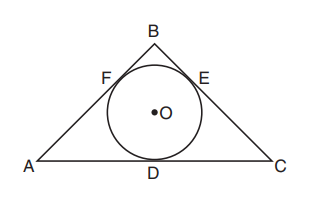Now that I'm caught up with the current New York State Regents exams, I'm revisiting some older ones.
More Regents problems.
Geometry Regents, August 2011
Part I: Each correct answer will receive 2 credits.
6. A straightedge and compass were used to create the construction
below. Arc EF was drawn from point B, and arcs with equal radii were
drawn from E and F.
Which statement is false?
1) m∠ABD = m∠DBC
2) 1/2 (m∠ABC) = m∠ABD
3) 2(m∠DBC) = m∠ABC
4) 2(m∠ABC) = m∠CBD
Answer: 4) 2(m∠ABC) = m∠CBD
This is a construction of an angle bisector. So ADB = DBC, ABD is 1/2 of ABC, and ABC is twice DBC. But ABC is the large angle, so it would equal twice CBD, not the other way around.
Choice (4) is false.
7. What is the length of the line segment whose endpoints are (1,−4)
and (9,2)?
1) 5
2) 2 √(17)
3) 10
4) 2 √(26)
Answer: 3) 10
Use the distance formula or Pythagorean Theorem. You may need to simplify a radical.
d = SQRT( (9-1)2 + (-4-2)2 )
= SQRT ( (8)2 + (-6)2 )
At this point, you should recognize that this will be the hypotenuse of a 6-8-10 triangle. If you didn't, continue with the calculations. You'll get 10.
8. What is the image of the point (2,−3) after the transformation ry-axis?
1) (2,3)
2) (-2,-3)
3) (-2,3)
4) (-3,2)
Answer: 2) (-2,-3)
The original point is in Quadrant IV. If you flip it over the y-axis, it will end up in Quadrant III. The signs will both be negative but the magnitude of the numbers will remain the same.
In other words, the image will be at (-2,-3), which is Choice (2)?
9. In the diagram below, lines n and m are cut by transversals p and q.
Which value of x would make lines n and m parallel?
1) 110
2) 80
3) 70
4) 50
Answer: 3) 70
For the lines to be parallel, x would have to be congruent to the corresponding angle, which is the unmarked one between the 30 and the 80 degree angles.
Those three angles make a straight line so 30 + 80 + x = 180. Therefore, x = 70.
10. What is an equation of the circle with a radius of 5 and center
at (1,−4)?
1) (x + 1)2 + (y − 4)2 = 5
2) (x + 1)2 + (y − 4)2 = 5
3) (x + 1)2 + (y − 4)2 = 25
4) (x − 1)2 + (y + 4)2 = 25
Answer: 4) (x − 1)2 + (y + 4)2 = 25
The equation for a circle is (x − h)2 + (y - k)2 = r2, where (h,k) is the center of the circle and r is the radius. There are minus signs in the formula, so the signs on the points are flipped.
Since the radius is 5, 52 = 25. Eliminate Choices (1) and (2).
Since the signs get flipped, the correct choice is (4).
More to come. Comments and questions welcome.
More Regents problems.
I also write Fiction!You can now preorder Devilish And Divine, edited by John L. French and Danielle Ackley-McPhail, which contains (among many, many others) three stories by me, Christopher J. Burke about those above us and from down below. Preorder the softcover or ebook at Amazon. Also, check out In A Flash 2020, by Christopher J. Burke for 20 great flash fiction stories, perfectly sized for your train rides. Available in softcover or ebook at Amazon. If you enjoy it, please consider leaving a rating or review on Amazon or on Good Reads. |
 |
 |




































